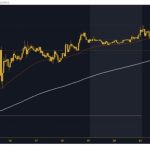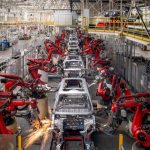
In a recent earnings call, Panasonic (OTC:PCRFY) Corporation (6752.T) detailed its performance for the second quarter of the fiscal year 2025, ending September 30, 2024. The company reported a 2% increase in total sales to 2,129.6 billion yen and an improved adjusted operating profit of 122.2 billion yen. Net profit also saw a rise to 118.3 billion yen.
The annual dividend is forecasted to grow by 5 yen to 40 yen, with a 30% payout ratio. Despite challenges in the Automotive and Energy sectors, Panasonic saw gains in the Lifestyle, Connect, and Industry segments, with generative AI-related sales expected to see significant growth.
Key Takeaways
- Total sales increased by 2% to 2,129.6 billion yen.
- Adjusted operating profit rose to 122.2 billion yen, with net profit up to 118.3 billion yen.
- The annual dividend is projected to increase by 5 yen to 40 yen, with a 30% payout ratio.
- Sales in Lifestyle were boosted by strong consumer electronics in Japan.
- Automotive segment faced production discontinuations.
- Connect segment grew due to Gemba solutions.
- Industry segment benefited from generative AI-related product sales.
- Energy segment sales were mixed, with growth in energy storage systems for data centers.
- Full-year forecast unchanged, but segment projections adjusted.
- Generative AI-related sales in the Industry and Energy segments to grow 1.8 times year-on-year.
- Company to focus on enhancing capabilities to meet generative AI demand.
- Panasonic remains cautious with investments, aligning them with market demands.
- The company is managing production capacity to meet storage battery demand.
- Improved year-on-year performance due to better inventory control and reduced head office expenses.
Company Outlook
- Full-year forecast remains steady despite segment adjustments.
- Generative AI-related sales expected to increase significantly.
- The company aims to improve profitability and ROI in its medium-term business plan.
Bearish Highlights
- Declines in Automotive and Energy segments.
- Slowdown in global EV demand, with moderate growth only in North America.
- Decline in Air to Water sales in the previous fiscal year’s first quarter.
- Challenges remain in markets like China.
Bullish Highlights
- Positive sales in Lifestyle due to strong consumer electronics in Japan.
- Connect segment growth from Gemba solutions.
- Industry segment sales boosted by generative AI products.
- Energy storage system sales for data centers on the rise.
Misses
- Lower product deliveries in avionics leading to Connect operating profit revision.
- Weakening demand in projectors post-Olympics in the US and Europe.
Q&A Highlights
- Management addressed investments in heat pumps and EVs.
- Focus on cash flow during the investment phase of the medium-term business plan.
- Plans to improve profitability and ROI.
- Panasonic discussed the new 4680 Wakayama plant for EV batteries.
- Consumer electronics sector in Japan saw a slight 1% growth.
- Exchange rate assumptions maintained for the second half of the fiscal year.
Panasonic Corporation continues to navigate a complex market environment, leveraging the growth in generative AI-related products while managing the challenges in the Automotive and Energy sectors. The company’s focus on customer needs, product evaluation, and strategic investments, particularly in battery manufacturing, underscores its commitment to long-term preparation and sustainability. Despite facing headwinds, Panasonic remains optimistic about achieving its revised forecasts and enhancing its market position through careful investment and capacity management.
Full transcript – Panasonic Corp PK (PCRFY) Q2 2025:
Hirokazu Umeda: Good evening. I will present the results for the Second Quarter of Fiscal 2025 ended September 30, 2024. For the second quarter, both sales and profit increased year-on-year. Overall sales increased due to increased sales in Lifestyle, Connect and Industry as well as currency translation despite decreased sales in Automotive and Energy. By business, positive factors were Industry and Energy with favorable sales of generative AI related products, while negative factors were Energy’s Automotive battery business affected by the year-on-year decrease in demand continuing through batteries produced in Japan and price revisions reflecting lower raw material costs. Adjusted operating profit increased overall with increased profit in Connect, Industry and Energy, despite decreased profit in Lifestyle and Automotive. Net profit increased adding the improvements in other income and loss and other factors. Operating cash flows increased year-on-year due to monetization of the IRA tax credit through transferable method. As for the full year forecast, the group wide forecast remains unchanged. However, the forecasts by segment are revised reflecting changes in each business environment. I will explain the details later. Annual dividend is forecasted at 40 yen, a year-on-year increase of 5 yen with a payout ratio of 30% as announced on August 30. Now the details of the consolidated final results for the second quarter. For the consolidated financial results, sales increased year-on-year by 2% to 2,129.6 billion yen. Sales excluding the effective exchange rates remained the same year-on-year. Adjusted OP increased to 122.2 billion, operating profit increased to 132.2 billion and net profit increased to 118.3 billion yen. This slide shows the results by segment. In the following slides I will explain the analysis of year-on-year comparison for sales and operating profit. First, the sales analysis by segment. In Lifestyle sales increased overall. This is due to steady sales of consumer electronics in Japan and electrical construction materials. Despite decreased sales of consumer electronics in China affected by weaker economy and Air to Water in Europe in which the rate of year-on-year decrease has become less severe compared to the first quarter. In Automotive, sales decreased due to such factors as discontinuation of production for certain models and sluggish sales mainly in China. In Connect, sales increased with increased sales of Gemba solutions due to steady orders of process automation by capturing certain investment opportunities, even with economic slowdown in China and a Blue Yonder with growing SaaS business. In Industry, sales increased with increased sales of products of generative AI servers, despite decreased sales of Industrial use relays and Automotive use relays and capacitors due to market slowdown, mainly in Europe. In Energy sales in In-vehicle decreased. This is due to continuing decrease in demand at the Japan factory. In addition, sales value decreased at the North American factory due to price revisions reflecting lower raw material prices, despite increased sales volume. In Industrial and Consumer, sales increased due to significant growth of energy storage system for data centers driven by generative AI advancement. Within other eliminations and adjustments, sales of both Entertainment & Communication and Housing remain the same year-on-year. Next, our adjusted operating profit analysis by segment. In Lifestyle, profit decreased due to lower sales of consumer electronics in China and Air to Water in Europe, despite steady sales of electrical construction materials. As for Air to Water in Europe, the year-on-year decrease amount has improved from the first quarter. In Automotive, profit decreased due to lower sales and higher fixed costs despite rationalization and price revisions to offset price hikes in parts and materials along with improved product mix. In Connect, profit increase due mainly to higher sales of process automation and Gemba solutions, despite such factors in avionics as upfront investments and impact of delivery delays by slower manufacturing of aircraft as well as deteriorated market conditions for media entertainment. In Industry, profit increased due to higher sales of products for generative AI servers, rationalization, price revisions and effective yen depreciation; despite decreased sales of Industrial use relays and Automotive use relays and capacitors. In Energy, profit in In-vehicle decreased only slightly. This is due mainly to the impact of decreased sales at the Japan factory, increased ramp up costs for the Kansas and Wakayama factories as well as upfront costs for new customers. While efforts such as improving productivity at the North America factory contributed to reducing this decrease amount. Profit in Industrial and Consumer increased due to a large contribution from increased sales of Energy storage systems for data centers and improvements in material market prices. Within other elimination adjustments, profit increased due mainly to improvement of elimination and income intercompany profits with the reduced inventories and improved head office income expenses. Results of Lifestyle by divisional company adjusted OP in Living Appliances and Solutions decreased due to lower sales of consumer electronics in China. Adjusted OP in HVAC decreased largely affected by lower sales of A2W in Europe. In Cold Chain Solutions and Electric Works, both sales and adjusted OP increased on continuing steady sales. And this is the year-on-year operating profit analysis by factor from left, Increased sales in real terms had positive impact of 6.9 billion. Increase in fixed cost pushed down profit by 18.7 billion yen due mainly to investments in Energy for business growth and impact of inflation. The net impact of raw materials and logistics prices was positive 12.7 billion. The effect of price revisions and rationalization was positive 18.8 billion. Among other individual factors, impact of IRA was positive 0.5 billion yen. Breakdown at Blue Yonder is shown in the bottom right box. Adjusted OP on a standalone basis increased by 1.2 billion on a constant currency basis. On consolidated basis, adjusted OP increased by 0.9 billion. Excluding the impact of strategic investment and synergy investment, adjusted OP was up 4.7 billion. Effective exchange rate was positive 1.6 billion, mainly seen in Industry and Energy. As a result, adjusted OP increased by 22.7 billion and OP increased by 29.8 billion yen. This slide shows the situation of cash flows and cash positions. On the left, operating cash flow was 457.6 billion yen, up year-on-year due to monetization of IRA tax credit through transferable method. Going forward, we will continue to generate further operating cash flows. On the right, net cash was negative of 540.6 billion yen. Next is fiscal 2025 full year financial forecast. This shows the full year forecast for fiscal 2025. The groupwide forecast remains unchanged from the initial forecast of May 9. This shows the forecast by segment. Reflecting the changes in the business and environment, revisions are made as shown in the columns labeled revised amount from May 9. This shows factors for sales and adjusted OP revision by segment. Sales forecasts are revised at all segments reflecting currency translation and business environment changes. Sales are revised upward in Lifestyle and Connect, revised downward in Automotive, Industry and Energy. Adjusted OP is revised downward in Connect, revised upward in other, eliminations and adjustments. However, the remaining segments are unchanged. The revision in Connect is made by factoring in the impact of delivery delays by slower manufacturing of aircraft for avionics and costs related to M&A by Blue Yonder. The revision in other, elimination and adjustment is made due mainly to improvement in head office income and expenses. This shows the four year forecast of Lifestyle by divisional company. Adjusted OP revised downward in Living Appliances and Solutions Company and China and Northeast Asia Company factoring in the impact of lower sales of consumer electronics in China. Next, let me explain the status of our generative AI related businesses, which are now rapidly growing. On the left in Industry, the relevant products include conductive polymer capacitors and multilayer circuit board materials for generative AI servers by capturing the market expansion opportunities. Sales are rapidly growing and annual sales are expected to reach a level of 35 billion yen, 1.8 times higher year-on-year. On the right in Energy, with the expansion of Gen AI market demand for Energy storage systems for data centers is rapidly increasing. Annual sales are expected to grow to a scale of above 100 billion yen, also 1.8 times higher year-on-year. For both Industry and Energy the full year sales forecast significantly exceeds the initial forecast. Growth is expected to continue in Gen AI related market, so we will enhance our capabilities to ensure capturing such demands. Lastly, let me explain shareholder returns. Today the Board of Directors resolved that the interim dividend of 20 yen per share for fiscal 2025, up 2.5 yen per share year-on-year. For the annual dividend, we forecast 40 yen per share, up 5 yen year-on-year. The payout ratio relative to the net profit forecast will be 30%. We will distribute stable and continuous dividend and aim to achieve enhanced corporate value through business growth and profit increase realized by our investments. Thank you for your attention.
Operator: From Nihon Keizai Shimbun, Nikkei Newspaper, Nakano San please.
Takashi Nakano: Thank you. This is Nakano. I hope you can hear me.
Hirokazu Umeda: Yes.
Takashi Nakano: Two questions. First, the focal investment areas heat pump, heating, what’s the current status? What is the market situation? And the other area is EV, so can you talk about the current situation and future prospect? My second question. Well, this is the end of your medium term plan. In terms of operating cash flow, I think you expect to achieve the target but not for others, it looks like. So with that in mind, what is your current take and any improvements that can be expected going forward.
Hirokazu Umeda: Thank you for your question. First, EV and Air to Water. Regarding EV, we have been saying that North America mostly focusing on North America in our business. Globally EV demand is slowing down but in North America compared to the past the growth has slowed down but 100% — about 110% or thereabouts has been the growth in units, so moderate growth. And at our plant in North America, depending on the situation of production in our customer sites, especially during the first quarter we were largely affected but towards second quarter about 0.5 gigawatt increase has been observed but our capacity is not at 100% but third quarter onward we expect the supply of batteries to continue, so in Q3 onward with the current plant we expect we’ll get closer to the full capacity and, as is shown in the IRA, 38 gigawatt or there about would be the target of our capacity increase. As for Japan for 1865 [Phonetic] produced in Japan, we do not expect further decline but we can’t expect further increase either and we are replacing the production line to a different model for 2170. So that’s the current situation regarding EV. Especially for Kansas and 4680 Wakayama plant, the new plant, we are making investments into those new facilities, that is for EV batteries. As for Air to Water, if you can look at page 29, towards the bottom, you can see the Air to Water situation. And if you can look at the graph on the lower right hand corner, in the first quarter of last year we have seen a rapid decline and for the first quarter of this fiscal year we feel that that was the bottom. And towards the third quarter and the fourth quarter, in terms of year-on-year comparison, we expect flat growth for sure, as opposed to a decline and that is because we are seeing improvement day by day. The rapid growth that we saw there is not expected, but at least we are seeing trend improving as reflected in the results for the second quarter. And given that situation for each country, we are embarking on new initiatives where we had not implemented initiatives. For the medium term business plan, the investment phase was where we were in and therefore cash flow was our focal point, of course. And there are some issues that became clear. One is the low profitability and roe. In other words, the return on the invested made, the absolute value is low and the rate the return was low. And so to address these aspects, we will be making efforts and that has been the message from our CEO as well. And so that by the end of FY27 there will be no businesses that do not meet the WAC requirements. That is all.
Takashi Nakano: Thank you.
Operator: Next from Gen [Phonetic] San from Denka Shimbu [Phonetic].
Unidentified Analyst: Gen is my name. Thank you very much. I have a very focused question about the Lifestyle business. The reasons behind the sales changes the domestic Consumer electrics did well. So looking at the Consumer electrics in Japan, what were their products which have grown and how much was the growth? Could you give us some details?
Hirokazu Umeda: Well, as for the consumer electronics in Japan, the Industry as a whole is still faced with the difficulties, but the market share has been increased on our part. So a little like 1% growth in comparison to the previous year that’s the growth that we saw, so it’s almost flat. And at our company, the washing machines, laundries and cleaners and a palm in shaver, those are the products which are selling well. So as Japanese consumer electronics, I think we achieved high profitability. So you asked about the Japanese market, so as a whole, we have seen a strong trend in Japan. Southeast Asia is also recovering. Also the Vietnam, which is one of the major markets, we saw the upturn and China is still tough and that was very clear in Q1 and Q2. That is our understanding. Thank you.
Unidentified Analyst: Thank you.
Operator: Thank you. Next Is from Nihon Keizai Shimbun, Morishita [Phonetic] San, please.
Unidentified Analyst: Thank you. Morishita from Nihon Keizai Shimbun. I hope you can hear me.
Hirokazu Umeda: Yes.
Unidentified Analyst: I have two questions. First, the impact of exchange rates. The yen is depreciating now, turning from the deep appreciation. So what is your current view and what impacts do you expect on your business? That’s my first question. And my second question, the full year forecasts, how am I to read this? No major revisions from the previous forecast, but when I see the factors for the revisions, I understand that there is a slowdown in the domestic OEM production. Is that the factor? And if the overall full year forecast remains unchanged, the slowdown in sales in domestic EV had already been incorporated and therefore that is the reason why the full consolidated forecast remains the same. Thank you.
Hirokazu Umeda: For exchange rates for the second half, we have not changed the assumed rates for yen and dollar, 140 yen to the dollar; for euro, 150 yen to the euro; for renminbi, 20 yen. So that’s the unchanged assumptions for the second half. As you know, the yen and Euro have fluctuated by more than 10 yen. And the sensitivity, as mentioned at the beginning of the year, regarding yen and the dollar and euro, the yen depreciation would push up our profit, where for renminbi, mainly in Lifestyle, when we import, the depreciation of the yen against the renminbi would negatively affect us. But given the range at the current rate, slight increase, slight gain on exchange rates is expected. In any event, the currency effect, when they fluctuate over a very short period of time, of course that’s not good for our business — running the business, that is. 140 yen, 155 yen within that range, that’s the assumption that we have in our business; that is against the US dollar. As for the full year forecast, yes, Automotive, that’s a complete OEM business. So Automotive OEM’s production unit volume is a direct driver of our business. So the production volume of the customers, when they increase, we make sure that we have sufficient supply, but currently we expect the decline in volume, so through the reduction in fixed costs, we’d like to overcome that. And as for a sales decrease, the materials price related or linked selling price is the formula that we use. So in the second quarter alone, 18 billion yen is the size of the price reduction, it appears. But in terms of volume in our North American plant, we expect increase and that is not the factor for a decline in sales. Overall, so there is the foreign exchange impact and yet we are maintaining our forecast, meaning that on a full year basis we expect some decline in sales, but in the generative AI related business and through the product mix, we can maintain the profit while the sales is expected to go down. And that is the reason why we are keeping the original forecast.
Unidentified Analyst: Thank you.
Operator: Next question is from TV Tokyo, Yamada [Phonetic] San, please.
Unidentified Analyst: This is World Business Satellite. I hope you can hear me.
Hirokazu Umeda: Yes.
Unidentified Analyst: Thank you. So you just mentioned the foreign exchange, I have one additional question on that. Today, the BOJ had the meeting and most recently the yen has been weak but slowly the yen is strengthening again. So what do you hope for from BOJ policy? Are there any things that you like them to do?
Hirokazu Umeda: Well, basically strong yen or weak yen, that is not the purpose of a BOJ, the government. How that government looks at the level of the foreign exchange is important. But from our perspective as a private sector, the range and the rapid change of that currency level is something that we like them to avoid as much as possible. So this time it remains the same. So in the medium to long term, as Panasonic, the interest rate, the world with interest rate to maintain it and gradually increasing interest rate is something that we assume in managing our company. That is our stance.
Unidentified Analyst: Thank you.
Operator: Thank you. I think it is time to end the journalist session. So we will only take one more question from journalists. Again only in Japanese. From Toyo Keizai, Mingaki [Phonetic] San.
Unidentified Analyst: Thank you. Mingaki from Toyo Kezai. In the — towards the next medium term management plan, is there a possibility of revisiting the portfolio of focal investment, especially in the Industry? The generative AI related I understand is very strong and my understanding is that it’s not included in the focal areas. Do you have any investment plans?
Hirokazu Umeda: Thank you. When we made that list, it’s been two and a half years ago and so things have changed dramatically in society and the investment speed is adjusted accordingly. So in terms of the investment areas going forward, just because the business is doing well doesn’t mean we will be making more investments there. For maintaining this three focal areas is not carved on the stone, so it’s subject to change of course. In the battery business, Panasonic is criticized for being very slow in making construction investments, so we’ve been very careful and the investment peak is behind us, so where would be the next investment is what we are revisiting. That is all.
Operator: Thank you very much. That concludes the Q&A session for journalists. Thank you very much. Now we would like to start the Q&A session for analysts and investors. If you have any questions, please Let us know. We are only taking questions in Japanese channel. From Goldman Sachs we have Harada San.
Ryo Harada: Thank you. This is Harada speaking. Two questions, first is in Energy. IRA tax credit excluded the first half and second half profitability is something that we are looking at. It seems that it’s worsening. So with the tax credit, it’s about 13% flat, so I would like to know the background. Is it because of the higher investments? Another second question is about the Gen AI. The growth is expected, you said. So Gen AI, I’m sure that there are a lot of activities going on and the growth rate is shown here. And with this realized, probably the growth rate would be much higher. So the manufacturing capacity, would there be any bottlenecks? 1.8 times were mentioned. If it doubles or triples, probably that’s more likely, so if I would like to know whether there is some impact expected. Thank you.
Hirokazu Umeda: In Energy from the first half to second half, yes, it appears that way, but it is in Wakayama, the mass production started and right now we are in the verification phase with customers, so there’s cost related to that. And Kansas startup or rather than startup, we introduced production line and operating it, and by the end of fiscal 2025, we are working on that. So because of those development activities that would be occurring in the second half. So in terms of the balance between first half and second half, as Harada San said, the investments would be necessary. So because of that, the number looks that way. Related to the generative AI, this growth is going to be big, but at the same time the production capacity, so for example, the automotive battery, when making a lot of them, that’s not something that we expect. Rather something that the customers evaluate is the storage battery in energy. So for example, creating a module, and the thermal capability and also the higher density as module, the customers evaluate our products. So number of the batteries is not so huge. And of course we will respond to the needs of the customers and we want to make sure that we can manufacture them, and that is always in our mind. As for the investments and the volume, that is not really the case. And in Industry, the electronics materials and the conductive polymer capacitors, they are growing, so necessary investments are being made. In Industry, the investment is increasing, I’m sure you can see that. So the batteries — unlike batteries which we need to prepare several years before and start it up, that is not the case. For the Automotive and also for the harsh environment, the thermal characteristics and so forth, we have been responding to that. And now that generative AI demand emerged, so we are responding to that. So we’d like to make sure that we catch up with such growth and we believe that we can manage such increase.
Ryo Harada: I see. Thank you very much.
Operator: Thank you. Next from Nomura Securities, Okazaki San, please.
Yu Okazaki: Thank you. Okazaki from Nomura. My first question is on slide six, the second quarter results, year-on-year others and eliminations getting better. I know that they’re intercompany and others. Can you elaborate on that? It was not really clear. My second question is on slide 33, the Blue Yonder indices SaaS AR rather strong recovery, so booking is strong, I understand, but how sustainable is this? One Network addition, is that pushing up the overall picture or is this attributable to the old organic growth, which is it?
Hirokazu Umeda: Thank you. For others positive, there are two major items, one is inventory. This is year-on-year comparison so it’s rather complicated, but in the previous year inventory did not go down much. So with increased inventory there will be the intercompany profit which will have to be eliminated, whereas for this year with the inventory control in place, as for the intercompany profits, the elimination of intercompany profits are being returned and therefore that is accounted for in the eliminations and adjustments and that amount was quite sizable. And the other is the head office expenses reduction, which continues and as a result other eliminations and adjustments increased pretty strongly. And the other question page 33, the Blue Yonder KPIs, SaaS, our One Network has been consolidated as of August, so this 16% increase is not totally attributable to that. But our sales and marketing have been reinforced and we are already seeing effect of that in the second quarter, so compared to the previous growth rates, we see an improvement. And on top of that, One Network Enterprises was a plus. Going forward, towards Q3, the One Network, you know, it’s already part of the business in second quarter and that will continue. Synergy will have to be incorporated and the orders received by Blue Yonder to improve, we have that expectation, and therefore SaaS ARR towards Q3 expects even greater growth.
Yu Okazaki: That answers the question.
Yu Okazaki: Thank you. Next is SMBC Nikko, Katsura San please.
Ryosuke Katsura: Thank you. This is Katsura speaking about the battery and also operating cash flow I have questions. First about the batteries, on page 23, 9.4 gigawatt hour I think was mentioned. So based on that December time frame, about 10 gigawatt hour, so in that sense toward next year in Nevada that would be the level that we can expect? I just wanted to confirm that, that’s my first point. And the second question is about the investments in Kansas, Wakayama, I think that in Energy this year you go to reach the peak level and next year and onwards when you consider free cash. So for this year, first of all with the IRA tax credit and also the one network cash out and also in connect there was a sale. So compared with the beginning of the fiscal year, there have been pluses and minuses. So could you talk about the operating cash flow this year and the next year?
Hirokazu Umeda: Yes, Ira on page 23, in Q1 and Q2, there is a lack of strength and we explained that. This has to do with the production module on the part of the customers. So it’s starting up of the production and we are starting saying the startup and the capacity that we have based on that, right now we are slowly operating. So from now on we will — toward the full capacity utilization 38.2 gigawatt hour is what we expect to reach. In addition, the productivity improvement is something that we are always working on. So toward the second half, capacity will be increasing. So at the full utilization, in the US, the factories which are operating, the capacity will slightly increase. That would be the image that we have. So that’s about the gigawatt hour. And second point is about the free cash flow. So for this year, Kansas, Wakayama investments we expected big investments. So free cash flow we aim — we want to aim for zero but the operating cash flow we are seeing a solid trend. But there are some investments that we have already decided upon, so free cash flow probably will be negative, but we have not given up on reaching zero. Next year, rather than big buildings, introducing the facilities and equipment would be what we would be doing. And in Blue Yonder, more than 100 billion yen acquisition was what we did. But the major investments will not be happening next year. So because of these, free cash flow will improve compared with this year. So that’s what I can say and that’s the image that we have.
Ryosuke Katsura: Thank you.
Operator: Thank you. Next from Citigroup Global Markets Japan, Ezawa San please.
Kota Ezawa: Thank you. Ezawa from Citigroup Global Markets Japan. Two questions. First, related to Katsura San’s battery question. Umeda San, you talked about next year’s free cash flow target of zero you said for the battery business. Might not be able to talk about exact amount, but given the current full year forecast for this year, with CapEx and appreciation and operating profit expectations, I cannot imagine achieving zero free cash flow in next year. So what are the elements that give you the confidence that you can get close to or achieve zero cash flow next fiscal year.
Hirokazu Umeda: Achieving or targeting zero, that is what that was not for the battery business in Energy. I was talking about the entire Panasonic group on a consolidated basis. For the battery business, with Kansas factory not likely to start the full capacity operation until FY27 and therefore the battery business, FY26 is when the facilities are built up and therefore, for the battery business, the free cash flow would be in the negative territory. But the cash flow generated on a company wide basis as well as the investments, as a net of those two, we expect better situation next year than this year. That was my intent.
Kota Ezawa: Got it. Thank you. My other question, on a consolidated basis your business results in Q2 when you focus on July-September quarter compared to your forecast, what was the delta? During the first quarter Umeda San you said that I was not really spectacular in light of the original forecast and that indicated that you were lagging behind the full year forecast, whereas this fiscal — this quarter, Q2, I got a different impression. So what changed in Q2 that made you sound more positive? And also can you elaborate on the revised forecast? And compared to that revised forecast, as CFO, where do you expect the upside opportunities as well as downside risks?
Hirokazu Umeda: Thank you. For July September quarter, objectively, compared to the first quarter, we did make recovery to a certain extent. The positives were generative AI related demand that I mentioned for Industry and Energy, they had a big impact and profitability, generally speaking, is high in this particular business and that was one driver. And in Connect process automation for implementation and those again, this is a profitable, high profitability business. It had been suffering for quite some time, but this quarter it contributed to increased profit. The Chinese government is implementing various initiatives to stimulate the economy and I think that’s one factor. As for process, there are still some uncertainties. We can’t say that it has recovered for sure. Maybe what we saw in the second quarter was very specific and maybe not sustainable. So, generative AI that’s certain to grow, continue to grow and that’s where I see the upside opportunities. And of course we are looking at the latest situation to make the forecast, so on the — regarding the full year forecast, I expect each business to achieve the revised forecast. For Connect, the aircraft manufacturing OEM saw the worker walk out, the strike, and that could have an impact. So there are some uncertainties making it very difficult to make very precise projection. Whereas in the Industry and Energy, the foreign exchange factor I believe would be positive to our profit. So some are doing better than others, but overall we believe that the current forecast is at the appropriate level, and that is the reason why we retained the original forecast.
Kota Ezawa: Thank you.
Operator: Thank you. Next, from Mizuho Securities, we have Nakane San.
Yasuo Nakane: Thank you. Hope you can hear me.
Hirokazu Umeda: Yes.
Yasuo Nakane: Nakane speaking. Two questions, please. First, about Connect operating profit, about the 5 billion for adjusted OP, I think you made a revision and Blue Yonder 4.5. Could you give us the difference, the breakdown 4.5 and 0.5, and is it related to the customer demand? I think the demand is strong. So talking about the recent shipment and also the balance of the order, could you give us some numbers? That’s my first question. The second Air to Water, maybe you can give me further details. So inventory adjustment progressed and selling increased, is that the case? Or toward the winter, the demand is it increasing more than the expectation? So in addition to the inventory adjustment, the higher demand, is that something that you are seeing? Also by region, are there any characteristics as a background? Thank you.
Hirokazu Umeda: Yes, in Connect the lower profit, the reason for that is Avionics is a major factor. So the product delivery has been much lower, so based on the current situation, we have made a downward revision and that was unavoidable. Also — but the projector related — the demand of the Olympic has come to an end and also US and Europe the demand has been weakening. So that is weaker than what we expected originally. Also Blue Yonder, of course, it is in the investment phase, including the restructuring cost and so forth, but mainly one network acquisition at that time, the cost for that acquisition in the original plan, we did not have that in our plan. So in terms of profit and loss, that is another factor, which shows this number. So about the process automation, the demand, the balance in Q2 it was very strong. Q3 and Q4 lower demand is what we expect. I cannot give you the specific numbers, but maybe the level of the Q1 it will be about the same level, especially in China, the labor saving investment and so forth. So we have already hit the bottom, so Q2 was strong temporarily. In Q3 and Q4, we are not expecting the major decline, but not much recovery. So that’s about Connect. The second point, the Air to Water, as I showed you a chart, the actual sales volume in Q1 yes, the bottom right. We seem to have hit the bottom in Q1. So Q2, every month is increasing and most recently that trend still continues. So the inventory in transit increased were accumulated, so our production, the utilization rate at the factory was lower, but the inventories, with the adjustment of the inventories, progressing. Production from — toward the Q4, production activities will be ramping up, so that would contribute to the profitability. So last year in Q3, Q4 it went down, so in comparison this year’s Q3, Q4, it’s not going to increase drastically but the lower level of the previous year is not something that we expect. By region or by country, of course that there is a impact of the tax credit or the subsidy, rather subsidy, so subsidy progress and some changes and concerning the subsidy, our competitors and players other players also have strengths and weaknesses depending on the countries and we also have some strength in some countries where we have reached the bottom and high demand. Aside from the specific name of the country, we will be taking the necessary measures, so that moving away from the bottom level of the Air to Water, so that’s what we are doing. Thank you.
Yasuo Nakane: Thank you very much.
Operator: Thank you very much. Now it is time to end today’s briefing. Thank you very much for your participation. We now conclude the second quarter financial briefing.
This article was generated with the support of AI and reviewed by an editor. For more information see our T&C.






